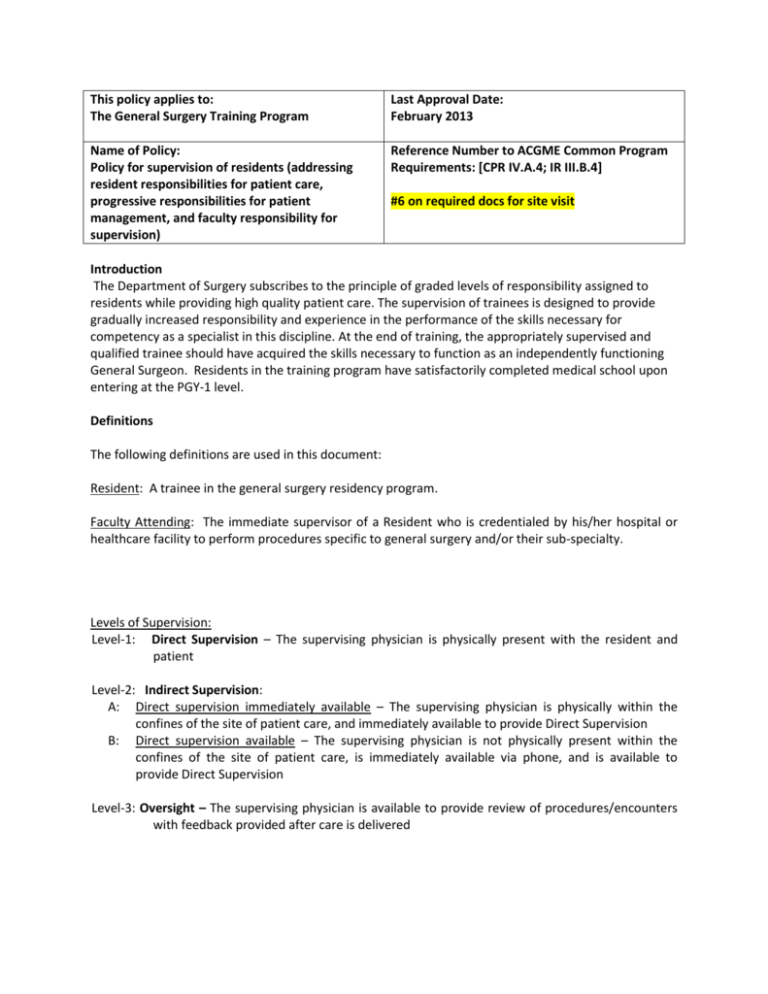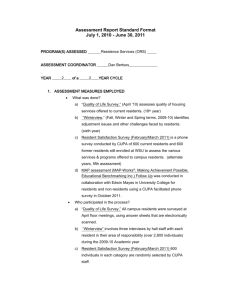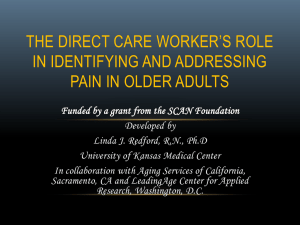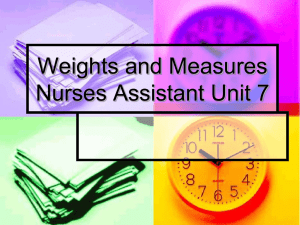Supervision Guidelines
advertisement

This policy applies to: The General Surgery Training Program Last Approval Date: February 2013 Name of Policy: Policy for supervision of residents (addressing resident responsibilities for patient care, progressive responsibilities for patient management, and faculty responsibility for supervision) Reference Number to ACGME Common Program Requirements: [CPR IV.A.4; IR III.B.4] #6 on required docs for site visit Introduction The Department of Surgery subscribes to the principle of graded levels of responsibility assigned to residents while providing high quality patient care. The supervision of trainees is designed to provide gradually increased responsibility and experience in the performance of the skills necessary for competency as a specialist in this discipline. At the end of training, the appropriately supervised and qualified trainee should have acquired the skills necessary to function as an independently functioning General Surgeon. Residents in the training program have satisfactorily completed medical school upon entering at the PGY-1 level. Definitions The following definitions are used in this document: Resident: A trainee in the general surgery residency program. Faculty Attending: The immediate supervisor of a Resident who is credentialed by his/her hospital or healthcare facility to perform procedures specific to general surgery and/or their sub-specialty. Levels of Supervision: Level-1: Direct Supervision – The supervising physician is physically present with the resident and patient Level-2: Indirect Supervision: A: Direct supervision immediately available – The supervising physician is physically within the confines of the site of patient care, and immediately available to provide Direct Supervision B: Direct supervision available – The supervising physician is not physically present within the confines of the site of patient care, is immediately available via phone, and is available to provide Direct Supervision Level-3: Oversight – The supervising physician is available to provide review of procedures/encounters with feedback provided after care is delivered Purpose This policy is a supplement to the Stanford GME “Residents Supervision Policy” which establishes the minimum requirements for resident supervision in teaching hospitals and healthcare facilities of Stanford Hospital and Clinics and Lucile Packard Children’s Hospital (see policy enclosed in this Resident Manual). This policy also mirrors the supervision guidelines provided in the general requirements by the ACGME for general surgery The medical staff of SHC, LPCH, and all general surgery residency integrated sites have the overall responsibility for the quality of the professional services provided to patients, including patients under the care of the residents. It is, therefore, the responsibility of the medical staff to ensure that each resident is supervised in his/her patient care responsibilities by a LIP (licensed independent practitioner) who has clinical privileges at all sites through their respective medical staff credentialing processes. IV. Operations A. Residents in surgery are supervised by credentialed providers (Faculty Attendings) who are licensed independent practitioners on the medical staff of all participating integrated and primary sites in which they are attending. The Faculty Attendings must be credentialed in that hospital for the subspecialty care and diagnostic and therapeutic procedures that they are supervising. In this setting, the supervising Faculty Attending is ultimately responsible for the care of the patient. B. The Program Director for the Residency Program in Surgery defines policies to specify how trainees become progressively independent in specific patient care activities in the program while being appropriately supervised by medical staff. Graduated levels of responsibility are delineated by a job description for each year of training. These Resident supervision policies are in compliance with The Joint Commission (TJC) policies on resident supervision. D. The supervision policies are distributed online to and are followed by trainees and supervising medical staff. Compliance with the specialty residency supervision policy is monitored by the Program Director. E. The Resident’s progress to the next higher level of training is determined annually by the Program Director according to the standards delineated in the list of clinical activities and following verbal or written feedback given by the faculty. The assessment is documented in the resident's bi-annual evaluations. Supervision of Residents in the Inpatient or Outpatient Setting Residents and Attending Staff should inform patients of their roles in the patient’s care at every new patient encounter. Faculty Attendings should delegate portions of patient care to residents. Residents should serve in a supervisory role to medical students assigned to their clinics. Senior (chief) residents at the PGY-4&5 levels should also serve in a supervisory role to junior residents at the PGY 1 through PGY-3 levels and to medical students. Circumstances and events where Residents must communicate with Faculty Attendings: Residents are encouraged to communicate with supervising Faculty Attendings any time that resident feel the need to discuss any matter relating to patient-care. The following are circumstances and events where residents must communicate with supervising Faculty Attendings: ● Encounters with any patient in emergency rooms ● All new patient encounters in intensive care or critical care units or inpatient units ● If requested to do so by other Faculty Attendings in any primary or specialty program ● If specifically requested to do so by patients or family ● If any error or unexpected serious adverse event is encountered at any time ● If the Resident is uncomfortable with carrying out any aspect of patient care for any reason ● Transferring patients to a higher level of care Documentation Requirements: Faculty attending supervision of care for hospitalized patients must be documented in the inpatient record. All new patient consultations performed by residents must be documented in the medical record or by computer entry, must include the name of the responsible onsite Faculty Attending and must personally evaluate all new patient consultations and provide evidence of his/her concurrence with the assessment, diagnostic and therapeutic plan (usually as an attestation to the resident note). All follow-up outpatient consultations performed by residents must be documented in the medical record or by computer entry, and must be discussed and seen promptly with the responsible onsite Faculty Attending. 1. Documentation that must be performed by Faculty Attending: Documentation in writing or by computer record of concurrence with admission history, physical examination, assessment, treatment plan and orders must be accomplished by the Faculty Attending within 24 hours of admission. The Faculty Attending must also document concurrence with major clinical decisions by specific written note in the medical record. 2. Documentation done by Resident: Residents may document patient care and staff supervision by writing consultation notes, progress notes, and/or cosigning notes written by medical students. Faculty Attendings are required to make teaching attestation to residents’ notes. The resident should provide documentation as the patient’s clinical condition changes. Residents should assist in documentation of informed consent, and refusal of care. Evaluations: The Faculty Attending must provide written evaluation of the resident’s performance online at the end of each rotation. Faculty are encouraged to also provide verbal and/or written resident performance evaluation mid-way through each rotation block. Evaluations should be discussed directly with the resident in addition to the written evaluation. Supervision of Residents Performing Procedures A Resident is considered qualified to perform a procedure independent upon completion of the procedure specific certification process. The list of procedures and patient type experiences for the Resident is specified in the following section. Each intern must complete the log of observed, assisted, then performed under supervision of a senior resident (PGY3-5) prior to independent practice. Completion of this sequence implies the competence of the residents in caring for these categories of patients or performing these procedures de facto under the good judgment of the Program Director. The procedure and grid below is a guide to supervision of procedures once the procedure logs are complete in the process for the interns. If the Program Director feels that the resident is not qualified to perform a procedure independently, that is duly noted in the resident’s individual file. The Faculty Attending of record remains ultimately responsible for all procedures performed by residents of any training level. All procedures performed independently by the Resident must be documented in the medical record or by computer entry and must indicate the Faculty Attending of record. Procedures Level of Supervision (See “Definitions” section) PGY-1 2 3 4 5 Abdominal Wound Closure 1 2A 2A 2B 2B Anuria 2A 3 3 3 3 Arterial Line 2A 2B 3 3 3 Bedside Debridement 2A 2B 3 3 3 Cardiac Arrythmia 2A 3 3 3 3 Central Line Placement 2A 2B 3 3 3 Change in Mental Status 2A 3 3 3 3 Change in Respiratory Rate 2A 3 3 3 3 Chest Tube Insertion 2A 2B 3 3 3 Endotracheal Intubation 2A 2A 2B 3 3 Excision of Soft Tissue Lesion 2A 2A 2B 3 3 Foley Catheter 2A 3 3 3 3 Hypertension 2A 3 3 3 3 Hypotension 2A 3 3 3 3 Hypoxemia 2A 3 3 3 3 Laceration 2A 2B 3 3 3 NG Tube Placement 2A 2B 3 3 3 Oliguria 2A 3 3 3 3 Paracentesis 2A 2B 3 3 3 Skin Closure 2A 2B 3 3 3






